Passionate About Pizza: Making Great Homemade Pizza (12 page)
Read Passionate About Pizza: Making Great Homemade Pizza Online
Authors: Curtis Ide
Tags: #Baking, #Cookbook, #Dough, #Pizza

You will notice that I recommend mixing a small portion of the flour with the liquid and all the remaining ingredients before adding all the flour. This ensures that the ingredients will incorporate uniformly into the dough. I prefer it but you do not need to do it this way.
Another alternative is to mix all the dry ingredients together in the bowl at once and use a whisk to stir them together into a uniform mixture. Then add all the wet ingredients and mix well until the dough comes together. You may need to add up to an additional half-cup or so of flour if the dough is very wet or sticky.
Wet Mix Method
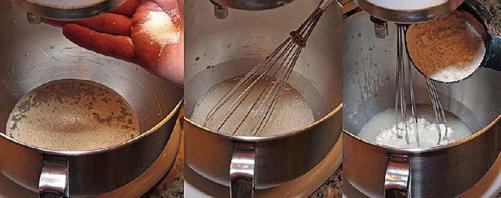
Pour the warm liquid in a large mixing bowl and sprinkle in the sugar (if using any) and the yeast; stir gently for a few seconds. Do not worry if the yeast and sugar does not dissolve completely right away. Let stand until foamy, about 10 minutes. You should begin to see the yeast multiply; it will produce bubbles and clumps that rise to the surface of the liquid. Waiting for the yeast to become bubbly is not necessary if you are very familiar with yeast baking and you know your yeast is active. Add 1/3 of the total amount of flour, the oil, and the salt. Mix thoroughly until it is smooth with no lumps.

Add the remaining flour (to the smaller end of the range of flour listed in the recipe) and mix well. The dough should come together and be fairly dry; you may need to add up to an additional 1/2 cup or so of flour if the dough is very wet or sticky.
Kneading Dough
The purpose of kneading is to develop the gluten in the flour. As it develops, the gluten protein transforms and creates long chains of protein. These chains form a matrix that holds the dough together. The gluten matrix also holds the bubbles created by the yeast, allowing the dough to rise. You accomplish kneading by squashing, stretching, or squeezing the dough against a surface. The friction produced by pushing the dough against the surface and the dough itself develops the gluten in the flour.
You will see a transformation occur as kneading progresses. What started out as just a mixture of flour and liquid will turn into smooth, supple, and elastic dough.
You can perform kneading by hand or by using a heavy-duty electric mixer, food processor, or bread machine. I recommend that even if you plan to use your electric mixer or food processor most of the time, you should try kneading the dough by hand a few times to get the feel of the dough and comfort with the process. This will make you more successful when using the mixer because you will know when the kneading is complete and how to correct issues and adjust the dough’s consistency.
If you use a heavy-duty electric mixer, food processor, or bread machine, follow the manufacturer’s instructions. If you knead by hand, follow these instructions:
Kneading by Hand
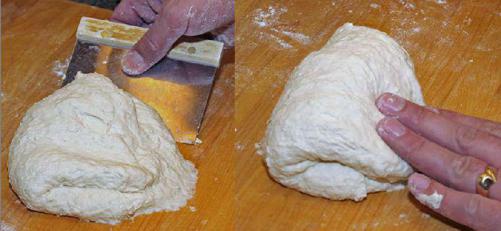
You can knead on any flat work surface, such as a counter or pizza board. Put the dough on the lightly floured work surface. Place one hand on top of the other and use the heel of your bottom hand to push the dough across the work surface, squashing the dough between your hand and the work surface.
Fold the dough over onto itself from one side to the other, turn it ninety degrees, draw it back towards yourself, and then push it across the work surface again. Sprinkle a little flour over the dough if it sticks to your hand or the work surface too much, remembering that it is okay for the dough to be a little sticky.
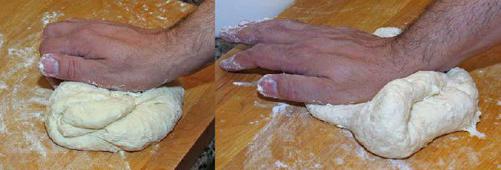
Repeat this action over and over, adding only as much flour as it takes to keep the dough from sticking to your hands too much. If you keep adding flour, you will have to knead longer and the dough will come out heavy and dense. You can use a dough scraper to facilitate the kneading process without continually adding flour. Just scrape up the dough, as you need to.
Work quickly and do not be delicate; squash and push the dough around to develop its gluten. To keep your arms from getting tired, use your weight by leaning onto your hands so that your weight does most of the work. Continue kneading only until the dough is smooth and elastic and no pieces of raw white flour show. Err on the side of too little kneading rather than too much. Over-kneading will result in tough dough.
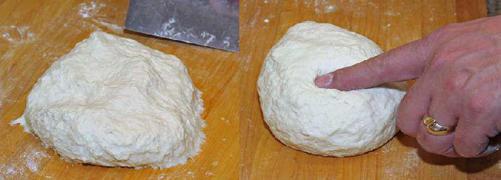
The hand kneading process should take five to ten minutes. You will notice a transformation in the dough as you knead it. The streaks of raw flour merge into the dough and are no longer visible. The dough becomes more resilient, holds together well, and turns a uniform color and texture; it should spring back when pressed. The dough turns from a mixture of flour and water into dough with a springy, consistent gluten-structure. The kneading is finished when the transformation is complete throughout the dough. The dough will then be somewhat stretchy, like Silly Putty®. Shape the dough into a ball for rising.
Kneading in a Mixing Bowl
You can knead your dough in your mixing bowl, if you want. Use the same procedure as described, except push the dough into the side and bottom of the mixing bowl. You might want to only use one hand and hold the bowl with the other hand. Be careful to use a sturdy bowl when doing this; it would be a shame to break a bowl that is too fragile!
Kneading with a Kitchen-Aid® Mixer
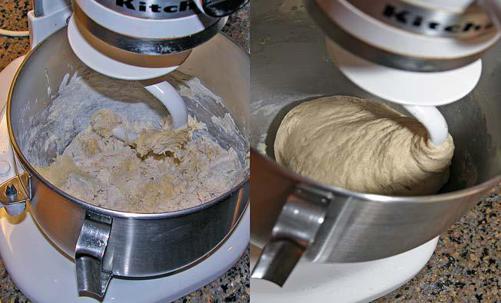
Using my Kitchen-Aid®, I start mixing with the paddle beater just until the dough has come together and almost all of the flour is incorporated. Then I switch to the dough hook to knead the dough until it is smooth and elastic. Overall, I think it only saves me about three to five minutes compared to mixing and kneading by hand. However, it is a little less work and a little less messy.
When I use my Magic Mill®, I use the wet mix method. I mix all the liquids, yeast, sugar, and oil (if being used) and one third of the flour together with the roller (or dough hook) and scraper until they are very well blended and smooth.
Kneading with a Magic Mill® Mixer

Then I add the remaining flour all at once. I continue mixing with the roller (or dough hook) and scraper just until the dough has come together and almost all of the flour is incorporated. When kneading, I let the mixer knead the dough until it is smooth and elastic. Overall, I think it only saves me about three to five minutes compared to mixing and kneading by hand. However, it is a little less work and a little less messy. When making very wet and sticky dough or when making large quantities of dough, the Magic Mill® mixer works especially well.
Letting Dough Rise

